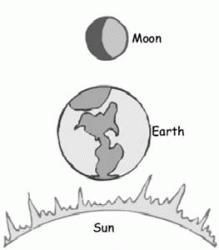

The New Horizons space probe similarly used Charon's shine to discover albedo variations on Pluto's dark side. In particular, the Cassini space probe used Saturn's shine to image portions of the planet's moons, even when they do not reflect direct sunlight. Planetshine has also been observed elsewhere in the Solar System. Typically, this results in the dark side of the Moon being bathed in a faint light. The most observed and familiar example of planetshine is earthshine on the Moon, which is most visible from the night side of Earth when the lunar phase is crescent or nearly new, without the atmospheric brightness of the daytime sky. Planetlight is the diffuse reflection of sunlight from a planet, whose albedo can be measured. Planetshine is the dim illumination, by sunlight reflected from a planet, of all or part of the otherwise dark side of any moon orbiting the body. Clementine's camera reveals (from right to left) the Moon lit by earthshine, the Sun's glare rising over the Moon's dark limb, and the planets Saturn, Mars, and Mercury (the three dots at lower left). The Moon lit by earthshine, captured by the lunar-prospecting Clementine spacecraft in 1994. Saturn's moon Mimas is lit by Saturnshine on the right and sunshine at the top.

Illumination by reflected sunlight from a planet


 0 kommentar(er)
0 kommentar(er)
